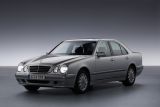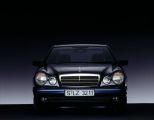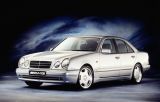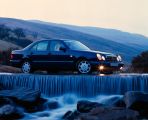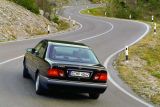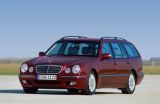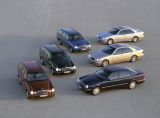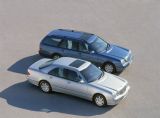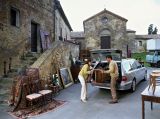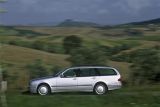Silver anniversary: 25 years of Mercedes-Benz E-Class in the 210 model series
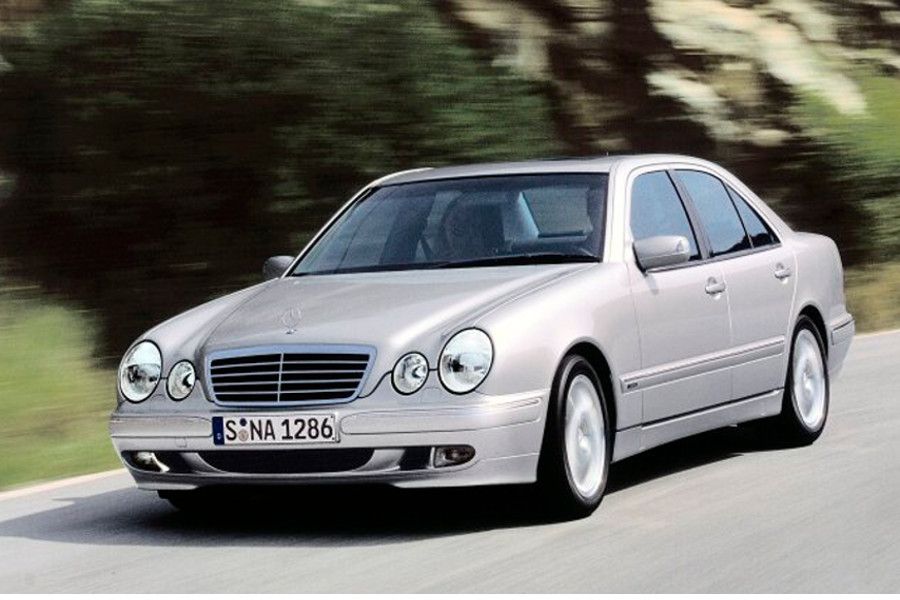
A new generation of E-Class began its successful journey a quarter of a century ago: in 1995, Mercedes-Benz introduced the 210 model series. It was the first time the E-Class with twin headlamps looked out at the world and promptly received the “red dot” design award. Another premiere in the luxury class was the choice between three design and equipment lines: CLASSIC, ELEGANCE and AVANTGARDE. The standard equipment included countless technical highlights from the electronic traction system (ETS) to the seat belt force limiter. Further innovations such as side airbags – a world premiere in this market segment – rain sensors and xenon headlamps were also available as special equipment.
The new E-Class started out in 1995 with the E 200, E 230, E 280, E 320 and E 420 as well as E 220 Diesel, E 290 Turbodiesel and E 300 Diesel. The output ranged from 70 kW (95 hp) in the E 220 Diesel to 205 kW (279 hp) in the E 420. In September 1995, at the International Motor Show (IAA), Mercedes-Benz introduced the E 50 AMG top model with 255 kW (347 hp). Throughout the entire term, the drives continued to be modernised and adjusted, and further models were added to the range – including the innovative E 220 CDI with common-rail direct injection in 1998 and the E 200 compressor in 2000. From 1997, the new M 112 and M 113 V engine series with three valves joined the E-Class.
The estate, lauded as a real spatial miracle with the largest cargo volume of its class, was introduced in March 1996 at the Geneva Motor Show. If necessary, an incredible 1,975 litres of luggage space are available. The automatic level control on the rear axle is standard equipment. Special equipment, on the other hand, includes a bench seat in the boot facing against the direction of travel with three-point seat belts, turning the estate into a seven-seater – the van market segment was still establishing itself in Europe.
Unlike its direct predecessor, the E-Class in the 210 model series was not available as a coupé or cabriolet. This segment was continued by the corresponding CLK versions of the 208 model series from 1997 onwards.
In June 1999, the E-Class in the 210 model series received a facelift. Since the premiere, over a million vehicles have been sold. Alongside a subtle body redesign, the standard equipment was expanded, particularly when it came to safety features. For example, all models now had the ESP® Electronic Stability Program, front side airbags and window airbags, whilst side airbags in the rear were available upon request.
Appropriately for the tradition of the E-Class, Mercedes-Benz also offered further versions of the 210 model series beyond the saloon and estate. There was a chassis with a 737-millimetre longer wheelbase and corresponding reinforcements, which was used as the basis for ambulances, for example. Mercedes-Benz also offered the 210 model series with special protection from 1995. The models E 320 and E 420/E 430 were available in special protection class B4. The E 420/E 430 was also available in special protection class B6 – the world’s only vehicle in the luxury class with this particularly high protection class.
In January 2001, Mercedes-Benz introduced the E-Class saloon of the following 211 model series. This debut marked the end of production of the 210 model series saloon after 1,374,409 vehicles. With average sales of more than 200,000 vehicles per year, it established itself as the best-selling executive saloon in the world. The E-Class share of this market segment was an average of 24 per cent; in some countries it was even as high as 40 per cent. The 210 model series estate remained in production until the end of the year – from 1996 to December 2002, more than 257,121 estate vehicles were produced. This meant a total of more than 1.6 million vehicles of the 210 model series in eight years of production. For the saloon, around two thirds of the vehicles had a petrol engine and a third a diesel engine under the bonnet. For the estate, this was almost exactly half and half.
The Mercedes-Benz 210 model series in the press
“auto motor und sport”, Germany, 11/1995 edition, describing the body of the saloon: “Besides representing the bravest leap in style in the history of the Mercedes brand, it also offers a significantly higher utility. More space, particularly in the rear, and increased functionality are directly visible improvements.”
“Road & Track”, USA, December 1995 edition, also offers judgement on the saloons of the 210 model series: “The new E-class is a dramatic departure for Mercedes-Benz. Historically, its cars – particularly the sedans – have been sold to ‘rational’ people seeking durability, timeless styling and understated luxury. But with this new E 320, Mercedes seeks to retain those buyers and attract people who are more emotional about their purchases, those who care more about style, handling and a car’s fun-to-drive quotient.”
Trade magazine “auto motor und sport” had this to say about the estate in its 6/1997 issue: “Otherwise, the estate sets the standards – particularly with its finely tuned suspension, which, even fully loaded, loses none of its smoothness.” And concludes with the sentence: “It is by some distance the best this class has to offer. Because it has not succumbed to a fashion trend that makes the estate an elegant fastback saloon with limited utility.”
Source of information
Daimler AG and ProfiBusiness.world
Date
June 12, 2021
Fotogalerie
Translator
ProfiBusiness.world
News and information
Agriculture
Animals and pet supplies
Automotive
Banking and insurance
Boats and shipping industry
Building and architecture
Business
Education
Electrical industry
Electronics
Engineering
Environment
Finance, taxes and accounting
Flowers and plants
Food and beverage industry
For companies
Forestry and wood processing
Furniture
Gastronomy and hotel industry
Glass, ceramics and porcelain
Healthcare and pharmacy
Hobby and garden
Home and household goods
HR
Hygiene, drugstore and cosmetics
Charity and social responsibility
Chemical
Institution
IT and computers
Law and legislation
Management and certification systems
Minerals
Office
Packaging and packaging technologies
Paper industry
Plastic and rubber industry
Power engineering
PR and marketing
Printing and printing technology
Railway industry
Real estate
Safety, security and protection
Science and research
Social services
Sport and relax
Steel and iron processing
Telecommunications and the internet
Textile and leather industry
Tourism
Toys, games and entertainment
Transport and logistics
